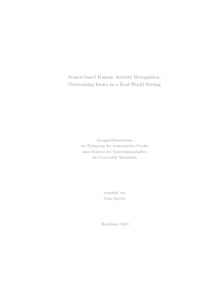|
Sensor-based human activity recognition: Overcoming issues in a real world setting
Sztyler, Timo
![[img]](https://madoc.bib.uni-mannheim.de/49914/1.hassmallThumbnailVersion/thesis_compressed.pdf)  Vorschau |
|
PDF
thesis_compressed.pdf
- Veröffentlichte Version
Download (6MB)
|
|
URL:
|
https://ub-madoc.bib.uni-mannheim.de/49914
|
|
URN:
|
urn:nbn:de:bsz:180-madoc-499144
|
|
Dokumenttyp:
|
Dissertation
|
|
Erscheinungsjahr:
|
2019
|
|
Ort der Veröffentlichung:
|
Mannheim
|
|
Hochschule:
|
Universität Mannheim
|
|
Gutachter:
|
Stuckenschmidt, Heiner
|
|
Datum der mündl. Prüfung:
|
9 Mai 2019
|
|
Sprache der Veröffentlichung:
|
Englisch
|
|
Einrichtung:
|
Fakultät für Wirtschaftsinformatik und Wirtschaftsmathematik > Practical Computer Science II: Artificial Intelligence (Stuckenschmidt 2009-)
|
|
Fachgebiet:
|
004 Informatik
|
|
Normierte Schlagwörter (SWD):
|
Maschinelles Lernen , Wearable Computer , Schlussfolgen , Sensorsystem , Körperliche Aktivität
|
|
Freie Schlagwörter (Englisch):
|
activity recognition , wearable sensors , external sensors , machine learning, probabilistic reasoning
|
|
Abstract:
|
The rapid growing of the population age in industrialized societies calls for advanced tools to continuous monitor the activities of people. The goals of those tools are usually to support active and healthy ageing, and to early detect possible health issues to enable a long and independent life. Recent advancements in sensor miniaturization and wireless communications have paved the way to unobtrusive activity recognition systems. Hence, many pervasive health care systems have been proposed which monitor activities through unobtrusive sensors and by machine learning or artificial intelligence methods. Unfortunately, while those systems are effective in controlled environments, their actual effectiveness out of the lab is still limited due to different shortcomings of existing approaches.
In this work, we explore such systems and aim to overcome existing limitations and shortcomings. Focusing on physical movements and crucial activities, our goal is to develop robust activity recognition methods based on external and wearable sensors that generate high quality results in a real world setting. Under laboratory conditions, existing research already showed that wearable sensors are suitable to recognize physical activities while external sensors are promising for activities that are more complex. Consequently, we investigate problems that emerge when coming out of the lab. This includes the position handling of wearable devices, the need of large expensive labeled datasets, the requirement to recognize activities in almost real-time, the necessity to adapt deployed systems online to changes in behavior of the user, the variability of executing an activity, and to use data and models across people. As a result, we present feasible solutions for these problems and provide useful insights for implementing corresponding techniques. Further, we introduce approaches and novel methods for both external and wearable sensors where we also clarify limitations and capabilities of the respective sensor types. Thus, we investigate both types separately to clarify their contribution and application use in respect of recognizing different types of activities in a real world scenario.
Overall, our comprehensive experiments and discussions show on the one hand the feasibility of physical activity recognition but also recognizing complex activities in a real world scenario. Comparing our techniques and results with existing works and state-of-the-art techniques also provides evidence concerning the reliability and quality of the proposed techniques. On the other hand, we also identify promising research directions and highlight that combining external and wearable sensors seem to be the next step to go beyond activity recognition. In other words, our results and discussions also show that combining external and wearable sensors would compensate weaknesses of the individual sensors in respect of certain activity types and scenarios. Therefore, by addressing the outlined problems, we pave the way for a hybrid approach. Along with our presented solutions, we conclude our work with a high-level multi-tier activity recognition architecture showing that aspects like physical activity, (emotional) condition, used objects, and environmental features are critical for reliable recognizing complex activities.
|
 | Dieser Eintrag ist Teil der Universitätsbibliographie. |
 | Das Dokument wird vom Publikationsserver der Universitätsbibliothek Mannheim bereitgestellt. |
 Suche Autoren in Suche Autoren in
Sie haben einen Fehler gefunden? Teilen Sie uns Ihren Korrekturwunsch bitte hier mit: E-Mail
Actions (login required)
 |
Eintrag anzeigen |
|
|
